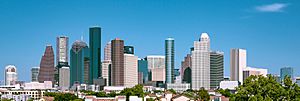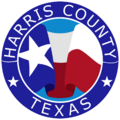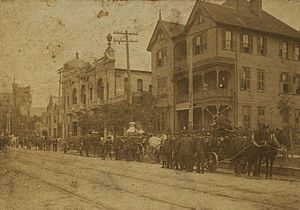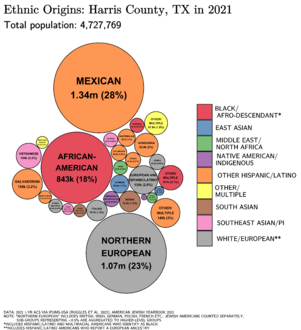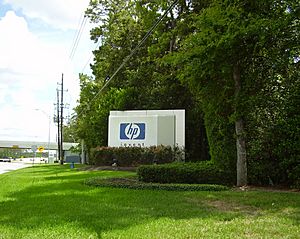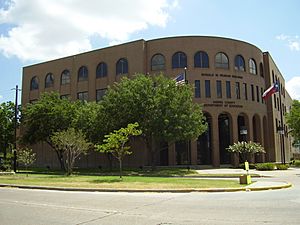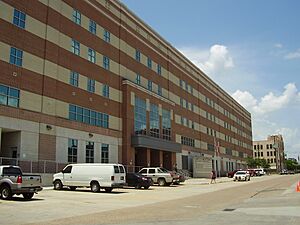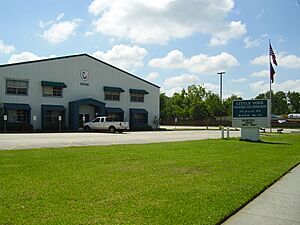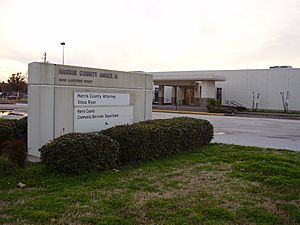Harris County, Texas facts for kids
Quick facts for kids
Harris County
|
||
|---|---|---|
|
Downtown Houston, Harris County Courthouse
|
||
|
||

Location within the U.S. state of Texas
|
||
 Texas's location within the U.S. |
||
| Country | ||
| State | ||
| Founded | December 22, 1836 | |
| Named for | John Richardson Harris | |
| Seat | Houston | |
| Largest city | Houston | |
| Area | ||
| • Total | 1,780.26 sq mi (4,610.9 km2) | |
| • Land | 1,706.96 sq mi (4,421.0 km2) | |
| • Water | 73.30 sq mi (189.8 km2) 4.2% | |
| Population
(2020)
|
||
| • Total | 4,731,145 | |
| • Estimate
(2023)
|
4,835,125 |
|
| • Density | 2,657.558/sq mi (1,026.0891/km2) | |
| Time zone | UTC−6 (Central) | |
| • Summer (DST) | UTC−5 (CDT) | |
| Congressional districts | 2nd, 7th, 8th, 9th, 18th, 22nd, 29th, 36th, 38th | |
Harris County is a large county in the U.S. state of Texas. It is the most populated county in Texas. It is also the third most populated county in the United States. In 2020, about 4.7 million people lived here. By 2023, the population grew to over 4.8 million.
The main city and county seat is Houston. Houston is the biggest city in Texas. It is also the fourth biggest city in the United States. Harris County was started in 1836. It is named after John Richardson Harris. He founded the town of Harrisburg in 1826. Harris County is part of the Houston–The Woodlands–Sugar Land area. This is one of the largest city areas in the U.S.
Contents
History of Harris County
People have lived in the Harris County area for a very long time. Scientists found human remains from about 4000 BC. Other signs of people living here date back to 1400 BC and 1 AD. The area was empty of people from 1 AD until Europeans arrived.
Not many Europeans visited before 1821. A Spanish explorer named Álvar Núñez Cabeza de Vaca might have visited in 1529. French traders passed through in the 1700s. Spaniards tried to build a fort, but they did not stay long.
The first European settlers arrived in Harris County in 1822. They sailed into Galveston Bay. Some traveled up the bay system. One settler, Mr. Ryder, settled at what is now Morgan's Point, Texas. John Iiams and his family also settled at Cedar Point in 1822. Dr. Johnson Hunter also settled at Morgan's Point. Nathaniel Lynch started a ferry service.
In 1824, Stephen F. Austin helped about 30 families get land titles. These families gained legal ownership of land in what became Harris County. Some early immigrants settled on Buffalo Bayou. These included Moses Callahan and Ezekial Thomas.
Nicolas Clopper came from Ohio in the 1820s. He wanted to use Buffalo Bayou for trade. He bought land at Morgan's Point in 1826.
John Richardson Harris (1790–1829) arrived in 1824. The county was later named after him. He moved his family from Missouri. Harris received a large piece of land. He started the town of Harrisburg in 1826. He also built a trading post and a mill. He used boats to move goods until he died in 1829.
The First Congress of the Republic of Texas created Harrisburg County. This happened on December 22, 1836. The county's borders changed in 1838. They were redrawn to what they are today.
Harris County has faced many strong storms. Here are some of the major hurricanes and tropical storms:
Geography and Nearby Areas
Harris County covers about 1,777 square miles. Most of this is land, about 1,703 square miles. The rest, about 74 square miles, is water. The total area of Harris County is larger than the entire state of Rhode Island.
Counties Next to Harris County
- Montgomery (north)
- Liberty (northeast)
- Chambers (east)
- Galveston (southeast)
- Brazoria (south)
- Fort Bend (southwest)
- Waller (northwest)
Cities and Towns
Harris County has many cities and towns. Some cities are located in more than one county.
Cities in Multiple Counties
- Baytown (also in Chambers County)
- Friendswood (mostly in Galveston County)
- Houston (county seat, also in Fort Bend and Montgomery counties)
- Katy (also in Fort Bend and Waller counties)
- League City (mostly in Galveston County)
- Missouri City (mostly in Fort Bend County)
- Pearland (mostly in Brazoria County)
- Seabrook (some water in Chambers County)
- Stafford (mostly in Fort Bend County)
- Waller (also in Waller County)
Cities Only in Harris County
- Bellaire
- Bunker Hill Village
- Deer Park
- El Lago
- Galena Park
- Hedwig Village
- Hilshire Village
- Humble
- Hunters Creek Village
- Jacinto City
- Jersey Village
- La Porte
- Morgan's Point
- Nassau Bay
- Pasadena
- Piney Point Village
- Shoreacres
- South Houston
- Southside Place
- Spring Valley Village
- Taylor Lake Village
- Tomball
- Webster
- West University Place
Unincorporated Areas (Not Part of a City)
Census-Designated Places
These are areas with many people but no city government.
- Aldine
- Atascocita
- Barrett, Texas
- Channelview
- Cinco Ranch (mostly in Fort Bend County)
- Cloverleaf
- Crosby
- Highlands
- Mission Bend (mostly in Fort Bend County)
- Sheldon
- Spring
- The Woodlands (mostly in Montgomery County)
Other Communities
- Alief
- Airline
- Bammel
- Barker
- Beaumont Place
- Bridgeland Community
- Cedar Bayou
- Champion Forest
- Cimarron
- Coady
- Cypress
- Dyersdale
- East Aldine
- Fall Creek
- Hockley
- Houmont Park
- Huffman
- Hufsmith
- Kinwood
- Klein
- Kleinbrook
- Kohrville
- Louetta
- Lynchburg
- McNair
- North Houston
- Northcliffe
- Northcliffe Manor
- Northgate Forest
- Remington Ranch
- Rose Hill
- Satsuma
- Traces
- Westfield
People and Languages
| Historical population | |||
|---|---|---|---|
| Census | Pop. | %± | |
| 1850 | 4,668 | — | |
| 1860 | 9,070 | 94.3% | |
| 1870 | 17,375 | 91.6% | |
| 1880 | 27,985 | 61.1% | |
| 1890 | 37,249 | 33.1% | |
| 1900 | 63,786 | 71.2% | |
| 1910 | 115,693 | 81.4% | |
| 1920 | 186,667 | 61.3% | |
| 1930 | 359,328 | 92.5% | |
| 1940 | 528,961 | 47.2% | |
| 1950 | 806,701 | 52.5% | |
| 1960 | 1,243,158 | 54.1% | |
| 1970 | 1,741,912 | 40.1% | |
| 1980 | 2,409,547 | 38.3% | |
| 1990 | 2,818,199 | 17.0% | |
| 2000 | 3,400,578 | 20.7% | |
| 2010 | 4,092,459 | 20.3% | |
| 2020 | 4,731,122 | 15.6% | |
| 2023 (est.) | 4,835,125 | 18.1% | |
| U.S. Decennial Census 1850–2010 2010–2020 |
|||
Harris County is very diverse. In 2020, there were over 4.7 million people living there. The county has many different racial and ethnic groups. About 25.6% of people were under 18 years old. About 12.1% were 65 or older.
In 2020, about 15.6% of people lived in poverty. A group called Children At Risk found that 21% of children in Harris County lived in poverty in 2007. They also found that 38% of high school students did not finish school.
As of 2023, Harris County has the second largest Black American population in the U.S. It is only behind Cook County, Illinois. It also has the second largest Hispanic population. This is only behind Los Angeles County, California.
Languages Spoken in Homes
In 2020, about 55.6% of people aged five and older spoke only English at home. The other 44.4% spoke another language. Spanish is the second most common language. About 35% of people speak Spanish at home. Other languages spoken include Vietnamese, Chinese, French, and Urdu.
Religious Groups
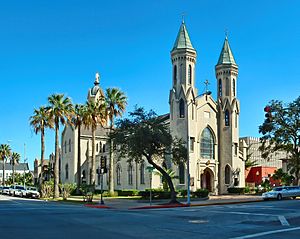
Many different religions are practiced in Harris County. In 2010, the largest religious group was Roman Catholics. They had over 1.9 million members. Southern Baptists were the second largest group. There were also many non-denominational Christians. Other groups include United Methodists and Muslims. There are also Mormons, Episcopalians, and Presbyterians.
How Harris County is Governed
A County Judge is the main leader of a Texas County. This judge leads the Commissioners' Court. This court is like a board of supervisors. In 2019, Judge Lina Hidalgo became the County Judge.
The county is divided into four areas called precincts. Each precinct chooses a Commissioner. This person represents their area on the court. They also help manage county government in their precinct.
Other elected officials in Harris County include:
- A County Attorney
- A County Clerk
- A District Attorney
- A District Clerk
- A Sheriff
- Eight Constables
- A Tax Assessor-Collector
- A County Treasurer
- All judges in the county (except city judges)
Many Harris County government offices are in Downtown Houston.
Economy and Jobs
The University of Houston System helps the local economy a lot. In 2011, it brought $1.1 billion into the Houston area. It created $3.13 billion in total economic benefit. It also created 24,000 local jobs. The university produces over 12,500 new graduates each year. Most of these graduates stay and work in the Houston area.
Many companies have their main offices in Harris County. Academy Sports and Outdoors has its offices and distribution center here. Hewlett-Packard (HP) used to have its U.S. office here. This complex was once the headquarters for Compaq. Now, Hewlett Packard Enterprise uses these offices.
Other companies with offices in Harris County include:
- Smith International
- BJ Services Company
- Cybersoft Technologies
- Noble Energy
- ExxonMobil (moved its headquarters here in 2022)
- Goya Foods (used to have Texas offices here)
- General Electric (has a facility here)
- Randall's Food Markets (has a distribution center here)
Education and Schools
The Harris County Department of Education helps local school districts. It has an Adult Education Center. It also runs the Highpoint Schools.
Many school districts serve Harris County. There are 26 districts in total. Some of them are:
|
|
|
In 2013, the North Forest Independent School District closed. Its area became part of Houston ISD. There are also state-operated charter schools in the county.
Colleges and Universities
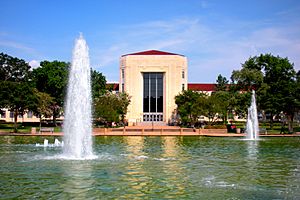
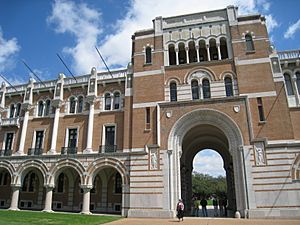
Harris County has four state universities. The University of Houston is a major research university. It is the third-largest university in Texas. It had over 43,000 students in 2016. The University of Houston–Clear Lake and the University of Houston–Downtown are also here. Texas Southern University is a large historically Black university.
Several private universities are also in Harris County. Rice University is a top teaching and research university. It is ranked among the best universities in the U.S.
There are five community college districts with campuses in Harris County:
- The Houston Community College System
- The Lone Star College System
- San Jacinto College
- Lee College
- Blinn College
The Houston Community College and Lone Star College systems are among the 10 largest colleges in the United States.
Public Libraries
Harris County has its own library system. It is called the Harris County Public Library. The city of Houston also has its own library system. It is called the Houston Public Library. Some cities like Baytown, Bellaire, Deer Park, and Pasadena have their own city libraries.
Emergency Services
Police and Law Enforcement
Cities in Harris County have their own police departments. The Harris County Sheriff's Office serves areas not in cities. It also helps city police forces.
Harris County also has a constable for each of its eight precincts. Constables and their deputies patrol the county. They keep the peace and provide security for county buildings.
Fire and EMS Services
The Harris County Fire Marshal's Office investigates fires. It also handles hazardous materials. Cities have their own fire departments. The Houston Fire Department serves the city of Houston.
Areas outside city limits get fire and medical help from Emergency Service Districts (ESDs). These are special government groups. They can collect taxes to pay for fire and EMS services. ESDs can provide services directly or hire other agencies.
Hospital Services
The Harris Health System provides hospital services for people in need. It runs two hospitals: LBJ General Hospital and Ben Taub General Hospital. It also has many clinics.
Many private and public hospitals are in Harris County. Some are in the Texas Medical Center. Others are located throughout the county.
Transportation
The Metropolitan Transit Authority of Harris County, Texas (METRO) provides public transportation. This includes buses and trains. Harris County Transit serves areas not covered by METRO.
For people driving, the average one-way commute is 25 minutes. For those using public transport, it is 44 minutes.
Major Roads and Highways
|
|
Public Transportation
The Metropolitan Transit Authority of Harris County, Texas (METRO) provides public transport. This includes buses and light rail. Harris County Transit serves areas not covered by METRO.
Bus Services Between Cities
Greyhound Bus Lines has several stations in Harris County. You can take a bus to other cities from here.
Airports in Harris County
Harris County has two major commercial airports:
- George Bush Intercontinental Airport
- William P. Hobby Airport
The city of Houston also operates Ellington Field. This airport is used for general aviation and military flights.
Other smaller airports for private planes include:
- La Porte Municipal Airport
- Baytown Airport
- West Houston Airport
- Dan Jones International Airport
- Weiser Air Park
- David Wayne Hooks Memorial Airport
- Sack-O-Grande Acroport (Harbican Airport)
- Hoffpauir Airport
See also
 In Spanish: Condado de Harris (Texas) para niños
In Spanish: Condado de Harris (Texas) para niños


